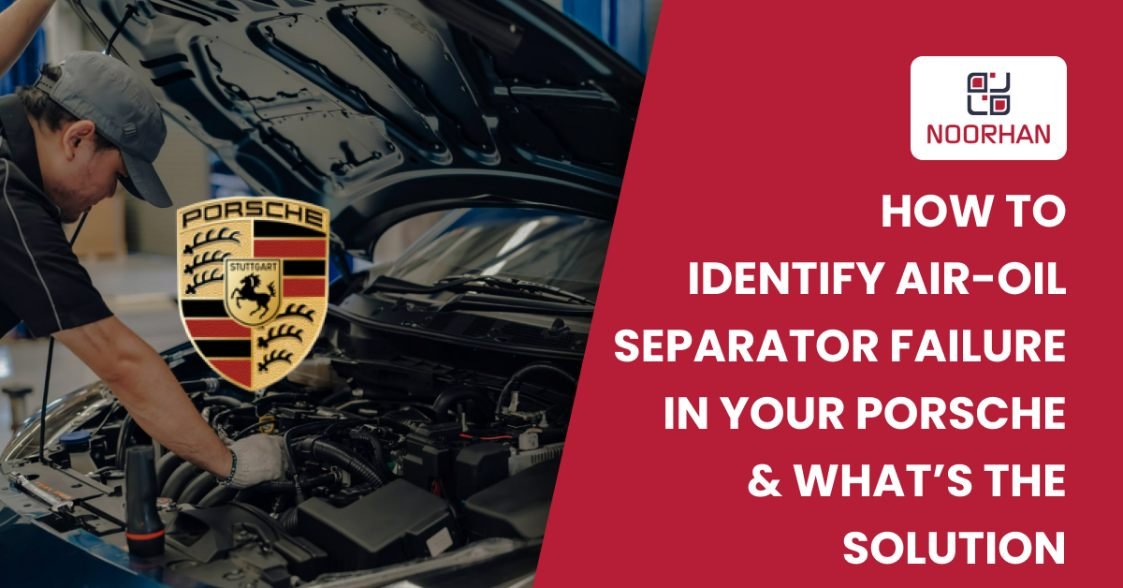-
Understanding the Air-Oil SeparatorUnderstanding the Air-Oil Separator
-
Signs of Air-Oil Separator FailureSigns of Air-Oil Separator Failure
-
Diagnosing Air-Oil Separator FailureDiagnosing Air-Oil Separator Failure
-
Solutions for Air-Oil Separator IssuesSolutions for Air-Oil Separator Issues
-
Preventing Air-Oil Separator FailurePreventing Air-Oil Separator Failure
As a proud Porsche owner, you’re likely aware of the exceptional engineering that goes into your vehicle. However, even the most well-crafted machines can experience issues over time. One component that may require your attention is the air-oil separator. In this comprehensive guide, we’ll explore how to identify air-oil separator failure in your Porsche and provide solutions to keep your vehicle running smoothly.
Understanding the Air-Oil Separator and Its Function
Before we dive into the signs of air-oil separator failure, let’s briefly discuss what this component does and why it’s crucial for your Porsche’s performance.
What is an Air-Oil Separator?
The air-oil separator, also known as the AOS, is a critical component in your Porsche’s engine. Its primary function is to separate oil from the air that gets vented out of the engine. This separation process ensures that only clean, oil-free air is directed back into the intake, while the oil is returned to the oil pan.
Why is the Air-Oil Separator Important?
The air-oil separator plays a vital role in maintaining your Porsche’s engine health and performance. By preventing oil from entering the intake system, it helps:
- Maintain proper combustion: Ensuring that only air and fuel are mixed in the combustion chamber enhances engine efficiency.
- Reduce emissions: By preventing oil from entering the combustion chamber, the air-oil separator minimizes harmful emissions.
- Prevent carbon buildup on intake valves: Reducing oil vapors helps maintain cleaner intake valves, enhancing engine longevity.
- Ensure optimal engine performance: A functioning air-oil separator helps the engine breathe properly, contributing to overall performance.
Signs of Air-Oil Separator Failure in Your Porsche
Identifying air-oil separator failure early can save you from more extensive and costly repairs down the road. Here are the key signs to watch out for:
1. Excessive Oil Consumption
One of the first indicators of air-oil separator failure is an increase in oil consumption. If you find yourself needing to top up your oil more frequently than usual, it could be a sign that your AOS is not functioning correctly. This situation can lead to lower oil levels, which can significantly impact engine performance and durability.
2. Blue or White Exhaust Smoke
If you notice blue or white smoke coming from your Porsche’s exhaust, especially during startup or acceleration, it could be a sign of air-oil separator failure. This smoke is caused by oil entering the combustion chamber and being burned along with the fuel. This symptom not only indicates AOS failure but can also lead to additional engine issues if left unaddressed.
3. Check Engine Light Illumination
Your Porsche’s sophisticated onboard diagnostics system may detect issues related to air-oil separator failure and trigger the check engine light. While this light can indicate various problems, it’s worth having it checked, especially if accompanied by other symptoms on this list. Ignoring the check engine light could lead to more serious complications down the line.
4. Decreased Engine Performance
Air-oil separator failure can lead to a noticeable decrease in your Porsche’s performance. You may experience:
- Reduced power and acceleration: A failing AOS can hinder airflow into the engine, impacting acceleration and overall performance.
- Rough idling: You may notice an inconsistent or shaky idle, indicating that the engine isn’t receiving the correct air-fuel mixture.
- Misfires or hesitation during acceleration: This can occur due to oil contamination affecting the combustion process.
5. Oil Leaks
A failing air-oil separator can cause oil leaks in your engine bay. Look for oil puddles under your car or oil residue on engine components, particularly around the area where the AOS is located. These leaks not only create a mess but can also lead to other components being affected by oil exposure.
6. Unusual Engine Noises
Listen for any unusual noises coming from your engine, such as whistling or hissing sounds. These could indicate a vacuum leak caused by a failing air-oil separator. Identifying and addressing these sounds promptly can help prevent further complications.
Diagnosing Air-Oil Separator Failure in Your Porsche
While the above signs can point toward air-oil separator failure, it’s essential to perform a proper diagnosis to confirm the issue. Here are some steps you or a professional mechanic can take:
1. Visual Inspection
Start with a visual inspection of the air-oil separator and surrounding components. Look for:
- Oil residue or wetness around the AOS: This can indicate a leak or failure within the component.
- Cracked or damaged hoses connected to the AOS: Damaged hoses can impede proper function and lead to additional issues.
- Signs of oil leaks in the engine bay: Any oil accumulation around the engine area should be investigated.
2. Crankcase Pressure Test
A crankcase pressure test can help determine if the air-oil separator is functioning correctly. On most Porsche models, the normal crankcase vacuum reading should be between -4.0” to -6.0” H2O (inches of water). A reading outside this range, particularly a higher vacuum, could indicate AOS failure. This test is often best performed by a qualified technician.
3. Smoke Test
A smoke test can help identify any leaks in the system. This involves introducing smoke into the crankcase and observing where it escapes, which can pinpoint the location of any leaks or failures in the AOS system. This diagnostic technique is effective in visualizing where air or oil may be escaping.
4. OBD-II Scan
Using an OBD-II scanner, check for any error codes related to the air-oil separator or crankcase ventilation system. While not all AOS failures will trigger a specific code, this can provide valuable information for diagnosis. Knowing the error codes can guide technicians in determining the root of the problem.
Solutions for Air-Oil Separator Failure in Your Porsche
Once you’ve confirmed that your Porsche is experiencing air-oil separator failure, it’s time to address the issue. Here are the steps you should take:
1. Replace the Air-Oil Separator
In most cases, the best solution for air-oil separator failure is to replace the entire unit. While it may be tempting to try and repair the existing AOS, replacement ensures optimal performance and reliability. Attempting to patch an air-oil separator may only lead to future problems.
Tips for AOS Replacement:
- Always use genuine Porsche parts or high-quality aftermarket alternatives designed specifically for your model. This ensures compatibility and performance.
- Replace all associated hoses and gaskets at the same time to prevent future leaks. Failing to address these components can lead to recurring issues.
- Consider upgrading to an improved AOS design if available for your Porsche model. Enhancements in design can lead to better performance and longevity.
2. Address Related Issues
Air-oil separator failure can sometimes be a symptom of other engine problems. When replacing the AOS, it’s a good idea to:
- Check and clean the intake system for any oil residue: Oil contamination can impact engine performance, so it’s essential to clean this area.
- Inspect and replace the PCV valve if necessary: A malfunctioning PCV valve can exacerbate AOS issues and should be addressed.
- Verify that the engine’s crankcase ventilation system is functioning correctly: This helps maintain the proper flow of air and oil within the engine.
3. Perform a Complete Oil Change
After replacing the air-oil separator, it’s recommended to perform a complete oil change. This ensures that any contaminated oil is removed from the system, giving your Porsche a fresh start. Fresh oil not only improves engine performance but also helps in maintaining optimal lubrication.
4. Reset Engine Management System
In some cases, you may need to reset the engine management system after replacing the AOS. This can be done using an OBD-II scanner or by disconnecting the battery for a short period (consult your Porsche’s manual for the correct procedure). Resetting the system can help clear any codes and allow the vehicle to recalibrate.
Preventing Future Air-Oil Separator Failure
To help prevent future air-oil separator issues in your Porsche, consider the following tips:
- Follow your Porsche’s recommended maintenance schedule, including regular oil changes with the correct grade of oil: Adhering to the maintenance schedule can significantly reduce the likelihood of AOS issues.
- Avoid short trips and extended idling, which can contribute to oil contamination and AOS stress. Short trips don’t allow the engine to reach optimal temperatures, leading to condensation and oil degradation.
- Allow your engine to warm up properly before driving aggressively: Warming up the engine helps it reach optimal operating conditions, reducing strain on components.
- Consider using high-quality synthetic oil, which can help reduce oil vapors and extend the life of your AOS. Synthetic oils often perform better under high temperatures and extreme conditions.
- Have your Porsche’s engine and emissions systems inspected regularly by a qualified technician: Regular checks can help identify potential issues before they become serious problems.
Read in detail: Know About Porsche Spare Parts
Conclusion: Keeping Your Porsche Running Smoothly
Air-oil separator failure in your Porsche can be a concerning issue, but with proper attention and care, it’s a problem that can be effectively addressed. By staying vigilant for the signs of AOS failure, performing regular maintenance, and addressing any issues promptly, you can ensure that your Porsche continues to deliver the exceptional performance you’ve come to expect.
Remember, while some maintenance tasks can be performed at home, diagnosing and replacing an air-oil separator often requires specialized knowledge and tools.







